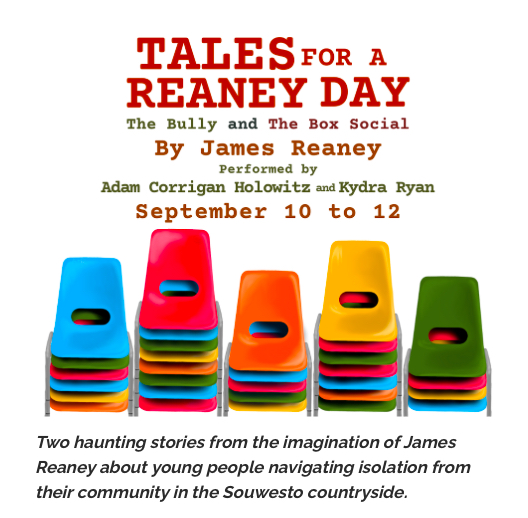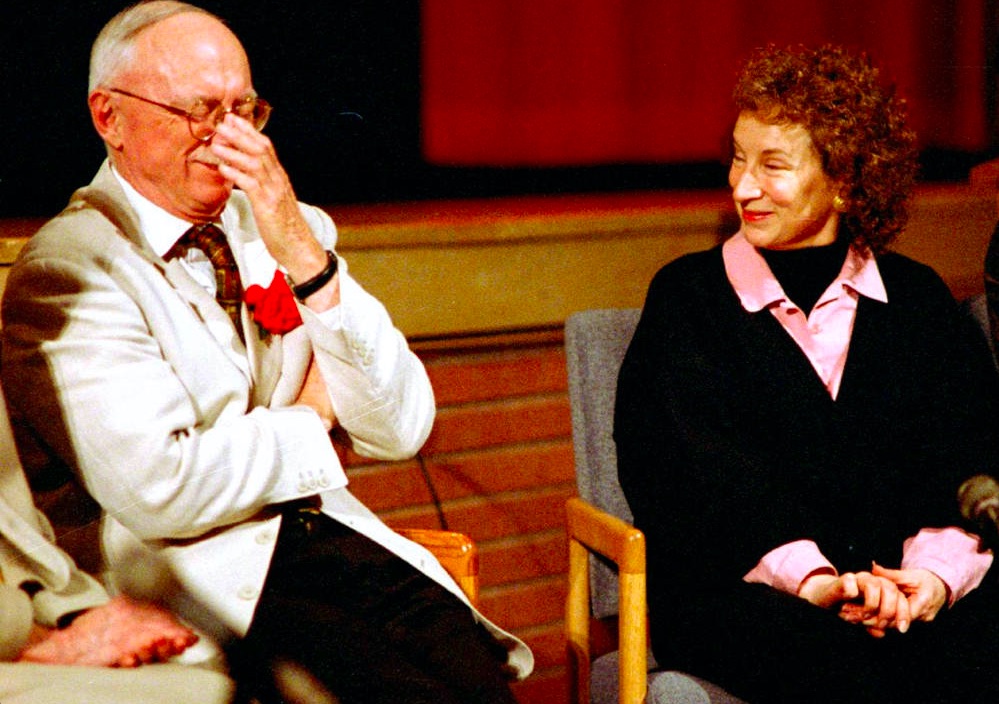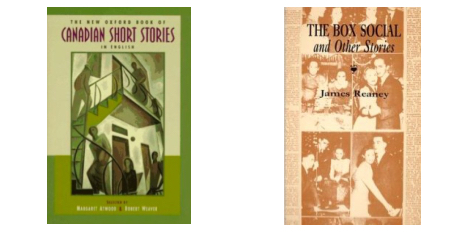On September 10, 11, and 12th, Alvego Root Theatre will present Tales for a Reaney Day – a double bill featuring two of James Reaney’s short stories, “The Bully” and “The Box Social”. Adam Corrigan Holowitz and Kydra Ryan are the co-directors and performers.
Where: Somerville 630, 630 Dundas Street, London, Ontario
When: Friday September 10 at 7:30, Saturday September 11 at 7:30, and Sunday September 12 at 4:00

More about James Reaney’s “neo-Gothic” short stories
“While an undergraduate at the University of Toronto [BA 1948, MA 1949], James Reaney published two stories, “The Bully” and “The Box Social,” that are not only classic Canadian short stories but are the first examples of a modern tradition called Southern Ontario Gothic (having its origin in the novels of John Richardson and some of the stories Susanna Moodie tells) that make use of Gothic elements of the macabre. In the four-page “The Box Social,” for example, a young man bids for a prettily wrapped shoe box, from a girl he made pregnant, that contains “the crabbed corpse of a stillborn child wreathed in bloody newspaper.” Margaret Atwood has remarked that “without ‘The Bully,’ my fiction would have followed other paths.” (The Concise Oxford Companion to Canadian Literature, William Toye, Ed., Oxford University Press, 2011, page 511.)
“The Box Social” was originally published in 1947 in The Undergrad at the University of Toronto, and then in the popular magazine The New Liberty. Here’s what Reaney had to say about why he wrote the story in his autobiography from 1992:
“Out of the deep past it somehow came to me, I think from my mother talking about the way men treated women in our neighbourhood. They never struck back; well, in my story one of them did.” (James Crerar Reaney, Contemporary Authors Autobiography Series, Volume 15, page 304.)
“The Bully” was broadcast in 1950 on CBC Radio and later published in Canadian Short Stories (1952) edited by Robert Weaver. While at university in the late 1950s, Margaret Atwood remembers discovering “The Bully” in Weaver’s anthology. “It made a big impression on me — it seemed a way of writing about Canadian reality that did not confine itself to the strict social realism that was mostly the fashion then.” (Excerpted from Margaret Atwood, “Remembering James Reaney”, Brick Issue 82 (Winter 2009), page 160.)

James Reaney and Southern Ontario Gothic
“James Reaney’s plays — Colours in the Dark (1969), Baldoon (1976), and The Donnellys (1974-7) — as well as his short stories “The Bully” and “The Box Social” (reprinted in The Box Social and Other Stories in 1996), also assume Gothic elements of the macabre rooted in nightmarish families and uncanny action. […]
What makes this locale so prone to Gothic tales is the failure of communication between family members or social groups. In the absence of communication, strange projections and psychological grotesqueries spring up and rapidly grow to unmanageable proportions. Malevolent fantasies are the source and sustenance of the Gothic tradition.” (Michael Hurley and Allan Hepburn in The Concise Oxford Companion to Canadian Literature, William Toye, Ed., Oxford University Press, 2011, pages 593-594.)
What do you mean by Gothic?
“…It’s the spirit of solitude, the isolated person rattling around, usually in an old dark castle in the early Gothic novels, but then in Faulkner in an old plantation house. In Ontario we can’t afford plantation houses so we have a farmhouse or an apartment building that has a lot of empty rooms in it, as in The Edible Woman…. It’s filled with the nightmare of life, but it’s this isolation that is at the bottom of it, I think, because of science. The whole Gothic tradition is already in Hamlet.” (Interview with James Reaney from July 23, 1991 from In the Writers’ Words: Conversations with Eight Canadian Poets, Laurence Hutchman, Guernica Editions, 2011, pages 173-174.)
More on the tradition of Gothic fiction
“Gothic fiction is a genre obsessively focused on the house. ‘Last night I dreamt I went to Manderley again’ is the famous first sentence of Daphne du Maurier’s Rebecca (1938). In some other kinds of stories, the house is a place of safety, a sanctuary from the world. But not in gothic fiction, where interior spaces become prisons for imperiled heroines or represent a domestic happiness from which the scarred male protagonist is excluded. Naturally the house in question is not just any house but sometimes a monastery, convent, prison, or insane asylum. In the female-centered gothic, the male owner of the castle is an older man with a piercing glance – aristocratic, obsessed, moody, and secretive, with qualities that mark him as a literary descendant of Satan in Paradise Lost….”(Catherine Sheldrick Ross, The Pleasures of Reading: A Booklover’s Alphabet, Libraries Unlimited, 2014, page 65.)
“The Bully” is included in The New Oxford Book of Canadian Short Stories in English, Oxford University Press, Toronto, 1996. It is also collected in James Reaney’s The Box Social and Other Stories (1996), published by Porcupine’s Quill.

